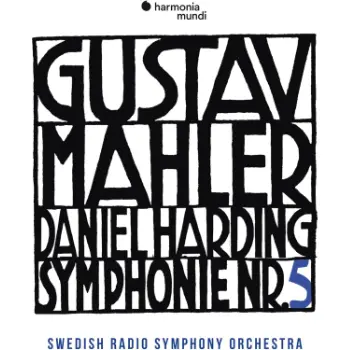There has been a slew of new Mahler 5th Symphony in the past few years, with some impressive versions indeed, most notably from The Bavarian Radio Symphony Orchestra under Mariss Jansons and from Osmo Vanskä and the Minnesota Orchestra. This release is the second of what Harmonia Mundi says will be a cycle of the Mahler Symphonies from Daniel Harding and the orchestra he elevated to impressive artistic heights – The Swedish Radio Symphony Orchestra.

If Vanskä and Jansons exemplified their ensemble’s unity, Harding opts for a more surgical, clinical separation of voices inside the score. And indeed, throughout this performance hidden voices and often missed jams from the orchestra’s sections come to life. I can’t recall, for instance, the pizzicato echoing of the strings in the second movement (2:40) better articulated than here, or the low strings contrapunct in the first bars of the first movement so clearly voiced.
Clinical experiments, as it’s well known, belly some risks; some will find the first movement, impressively transparent as it may be, a bit too slow to handle. In the second movement, one can pass on the accuracy for a more triumphant outburst (12:40). These bars were embraced wholeheartedly by Jansons and his German team and hastily rushed over on Vanskä’s version. Harding sits somewhere in the middle – supplying a round, well-balanced blend of the instruments but maybe controlled to a fault. I liked his choice of tempo for the Scherzo, though, even if a bit slower than usually taken (“Nicht zu schnell”, Mahler directs in the score). It’s still humorous, but more darkly so, which seems much more inlined with Mahler’s intent. Here again, all through this movement, the transparency and observation of hidden voices of sections of the orchestra are uncanny, helped by a state of the art recording, on par with Harmonia Mundi’s best (Listen to the last 30 seconds or so of this movement in a good sound system and you’d be blown away).
The famous Adagietto is impressive by the sheer control of the Swedish strings players in hushed pianissimos, with very little to almost no vibrato. One of the characteristics of this group, which sets it apart from other European orchestras, is this sharp, lean quality they get from their instruments. It’s not merely “historically aware”, It’s a sound which is a part of their identity. This Adagietto is a sincere, direct and somewhat restrained performance, which is not to say lacking in effectiveness. When the group delves into the lower registers (3:55) they bring their all, as if preserved their power for this moment.
The rondo-finale is well planned, starting off with gracious playfulness (again, as instructed by the composer), and finishing off with a virtuosic display from all players.
This version requires few hearings to fully appreciate. It’s a different kind if Mahler – a more transparent, interpreted from the inside-out and with the score fully observed by the conductor, dispensing with some “bad habits” of many decades (where are some of the big crescendos in the opening movement’s first bars, you ask? They don’t really exist in the score!). A comparison with famous past versions is fascinating, and encouraged. I won’t live without Sir John Barbirolli’s legendary version, Abbado’s Berlin take, Chailly with the Concertgebouw or a personal favorite – Boulez with the Vienna Philharmonic. But I will get back to this new refreshing version, and will eagerly await the rest of the cycle.
Images: ©️ Julian Hargreaves and Harmonia Mundi
Mahler – Symphony No. 5
Swedish Radio Symphony Orchestra
Daniel Harding – Conductor
Harmonia Mundi, CD HMM902366



















